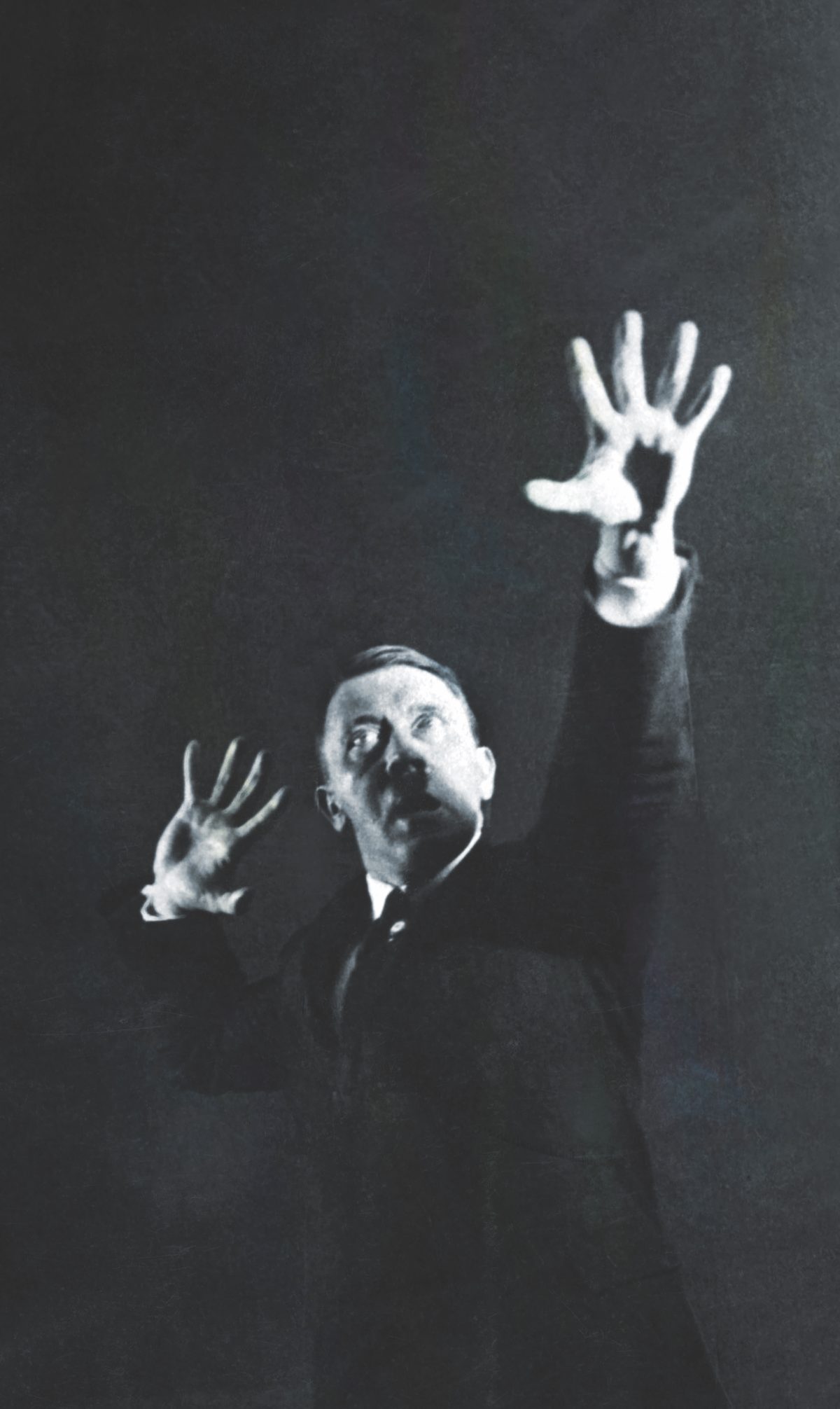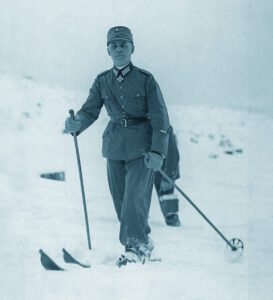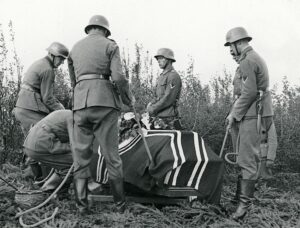In March 1940, Hans Bender, Germany’s best-known parapsychologist, wrote to Karl Ernst Krafft, a young Swiss astrologer he had known since his days as a doctoral student at the University of Bonn a decade earlier. Krafft had recently ingratiated himself to Nazi leaders by seeming to predict the attempt to assassinate Adolf Hitler at the Burgerbraukeller in Munich on November 8, 1939, when a carefully planted bomb had exploded, killing eight of his supporters and injuring 63 others. (The führer had left the beer hall minutes before.) Bender complained to Krafft that Nazi authorities were once again cracking down on occultism and on practitioners of “border science”—the study of supernatural forces that supposedly rested on the border between the real and the unseen world, encompassing such pseudosciences as astrology, clairvoyance, graphology, palm reading, mind reading, mediumism, phrenology, and telepathy. Bender worried that the well of Nazi financial support and patience for such activities was running dry.
Although Hitler, Schutzstaffel (SS) leader Heinrich Himmler, and other high-ranking Nazis had shown a longstanding interest in the paranormal, they worried that an overreliance on occult beliefs would distract the German people from the teachings and tenets of National Socialism. As always, the state came first. “National Socialism is a cool and highly reasoned approach to reality based on the greatest of scientific knowledge and its spiritual expression,” Hitler had declared in 1938. “This philosophy does not advocate mystic cults, but rather aims to cultivate and lead a nation determined by its blood.” Of course, Aryan racial purity in itself was a kind of cult, but Hitler didn’t worry about making such statements—no one would dare to contradict him.
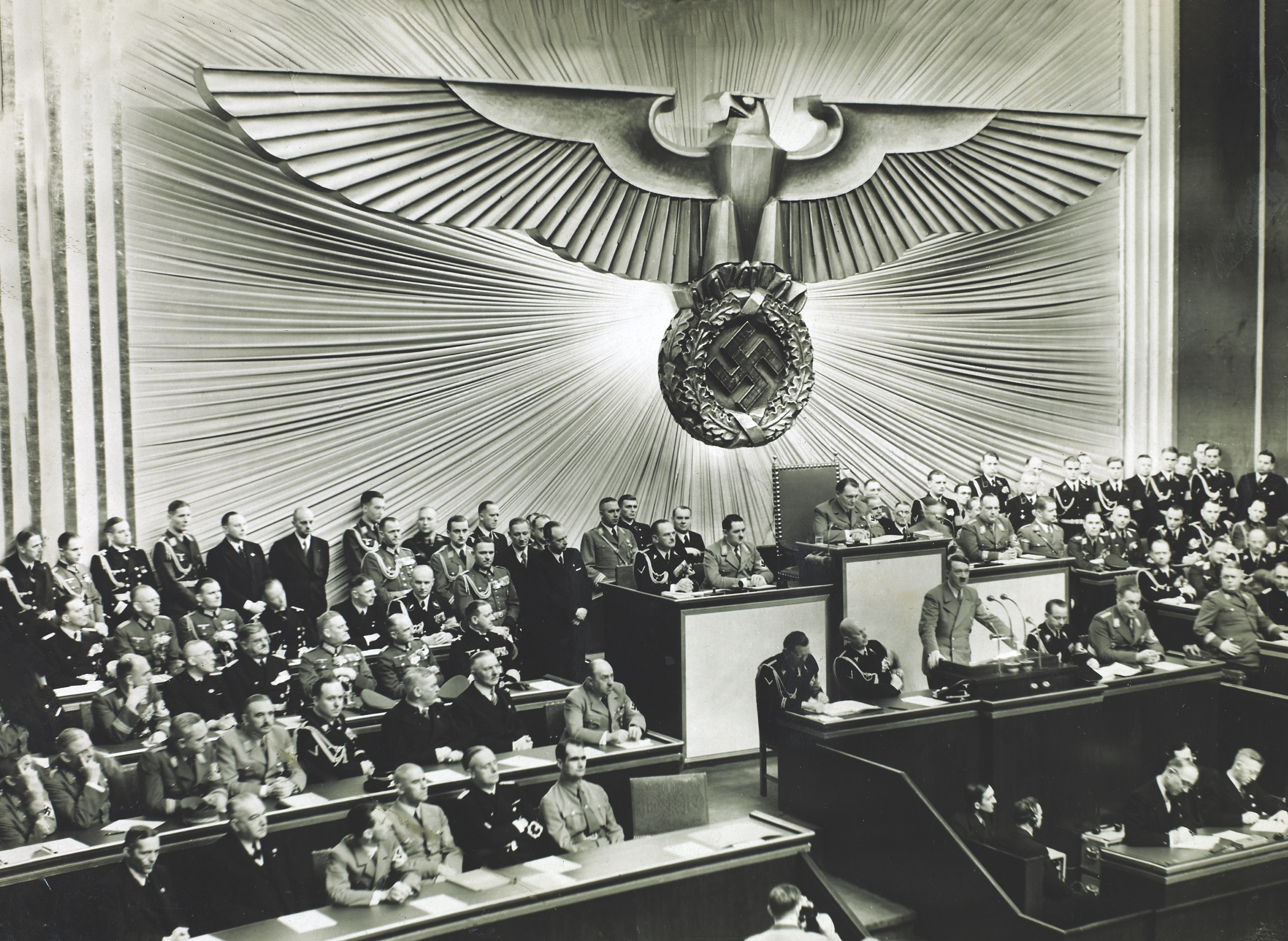
A mild—by Nazi standards—crackdown on border science had already taken place between 1933 and 1937. The Reich Office for Public Health (Reichsversorgungsgesetz, or RVG), headed by Dr. Bernard Hormann, led “pro-enlightenment efforts” to ferret out what Hormann called the “obvious deceivers and conscienceless exploiters of people’s lack of knowledge and helplessness.” Again, this was what the Nazis themselves were doing on a massive scale. Even as they railed against “dangerous superstition,” the Nazis held gigantic rallies at Nuremberg where enthralled crowds were whipped into mass hysteria by goose-stepping party members brandishing gold-plated flagpoles topped with enormous runic swastikas. Meanwhile, Joseph Goebbels, the Nazi propaganda minister, was actively encouraging research in “scientific astrology,” if for no other reason than that it was still popular with rank-and-file Germans.
British intelligence services, aware that Hitler and the Nazis were avid horoscope readers, planted false horoscope predictions and made much of the führer’s supposedly bad-luck Taurus sun sign. German propagandists decided to employ similar methods against the Allies. On October 30, 1939, less than two months into the war, Goebbels announced that he was reexamining astrology with an eye toward using it for propaganda purposes. Two weeks later he showed Hitler and Himmler a letter from Karl Krafft that appeared to have predicted the assassination attempt against the führer by German leftist Georg Elser. Krafft’s prediction (that Hitler’s life would be in danger November 7–10) fascinated the führer, and he asked Goebbels to look into how Krafft had managed such an accurate prediction. Himmler, who at the time was soliciting astrological materials for his own occult library, agreed with Goebbels’s findings that the letter and its prediction were genuine. Goebbels was encouraged. “The whole world is full of mystical superstition,” he wrote in his diary two days later. “Why shouldn’t we exploit that in order to undermine the enemy front?”
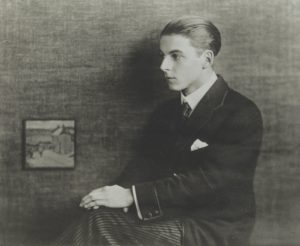
Now committed to using astrology for propaganda purposes, Goebbels banned German civilians from making their own astrological predictions. He wanted to make sure, as always, that he controlled the message. He also drew a clear distinction between the “scientific astrology” that Hitler, Himmler, and other Nazis endorsed and the “propagandistic [but] not scientific” brochures his ministry would produce. Like many of his colleagues, Goebbels appeared to accept that “scientific” astrology was indeed possible, if not really necessary for spreading false predictions.
In addition to building a team of crack astrologers, Goebbels paid a visit to H. H. Kritzinger, a renowned radiesthesiologist, or water dowser, to see if he had anything to contribute to the propaganda project. Kritzinger, who was busy with his own work, recommended that Goebbels check with Krafft instead. Krafft was already using astrology to advise Virgil Tilea, the Romanian ambassador to Great Britain, whom he was attempting to convince to side with Germany. Before talking with Krafft, Goebbels had delegated Hans Herwath von Bittenfeld and Leopold Gutterer, two officials in the Ministry for Popular Enlightenment and Propaganda, to draft a propaganda pamphlet based on the works of the 16th-century French astronomer and mystic Michel de Nostradame, better known as Nostradamus. Bittenfeld and Gutterer, who were hardly experts in the field, cherry-picked Nostradamus’s work for supposedly pro-German prophesies justifying Hitler’s systematic violations of the Versailles Treaty, which had ended World War I on terms highly unfavorable to Germany. Under Hitler, Germany had consistently violated the treaty by canceling the payment of war reparations, annexing territory in the Rhineland, and raising and rearming a large standing army inside Germany. As proof of Germany’s destiny, they cited Nostradamus’s quatrain: “The great empire, dismembered early / Will grow from the inside out / From a small country. / In his lap the sceptre shall rest.”
Goebbels directed that the propaganda pamphlet address Germany’s “temporary” occupation of France and the coming Thousand-Year Reich that Hitler had boldly predicted in 1934. Citing radio reports from France, Goebbels bragged: “Our panic propaganda in France is very successful. Over there Nostradamus-followers represent a fifth column. We’re increasing our efforts in that respect. Most of the day is spent on this project.” After they produced a series of brochures predicting German victory that Goebbels deemed “outstanding,” Bittenfeld and Gutterer were instructed to develop horoscopes of other European leaders, along with astrological crossword puzzles to be distributed across France and the Low Countries (Belgium, the Netherlands, and Luxembourg), presumably for entertainment purposes, after Germany had occupied them.
Bolstered by the arrival of Krafft and another “scientific” astrologer, Georg Lucht, the Nostradamus division began preparing brochures for the upcoming invasions of Denmark, Norway, and the smaller western European countries. Krafft and his colleagues soon became full partners of the regime. Krafft, who spent much of the spring of 1940 attending lavish parties and society events where he met and mingled with leading Nazis, reassured his colleague Bender that the government would continue to support border science research. “About the prospects of border sciences in our generation, I’m not as pessimistic as you,” Krafft wrote to Bender. “Especially in government circles, they are seeking people [who] have something to say.”
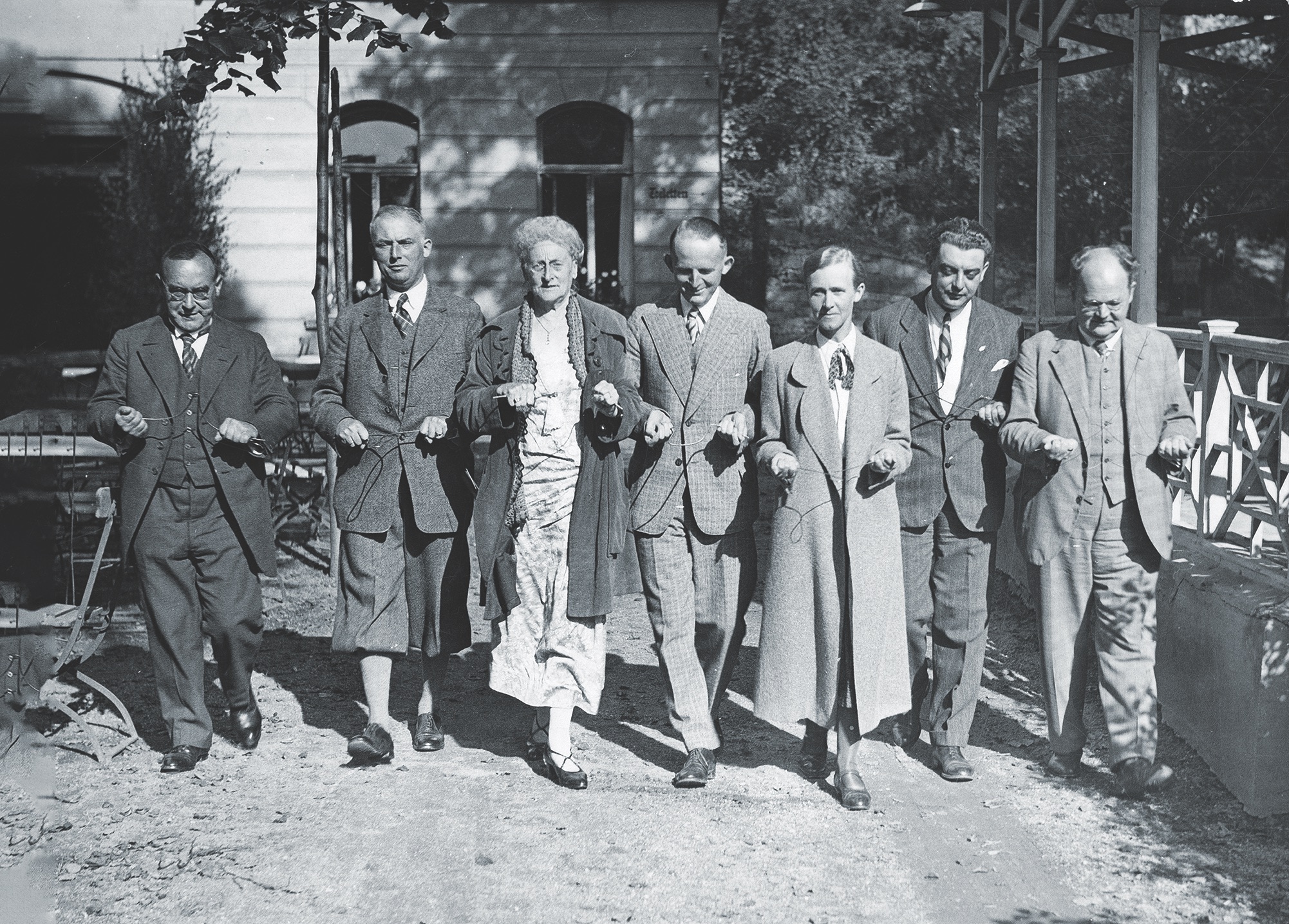
Privately, however, Krafft and Lucht were beginning to have serious qualms about Goebbels’s manipulation of their prophecies. Lucht quit abruptly on April 2, 1940, and Krafft resigned from the Propaganda Ministry a few months later, returning to what he termed his “private practice.” Nonetheless, Goebbels continued to use Krafft’s pamphlets and books, even after Krafft made several indiscreet public references to “impending military operations in the east”—meaning the top-secret invasion of the Soviet Union—that did nothing to endear him to the Nazi regime. For nearly a year after his resignation, Krafft continued making unsanctioned predictions. The dreaded Gestapo (German secret police) bided its time and kept a close eye on Krafft and his charts.
After the Nazis overran France in June 1940, Goebbels shifted the focus of his propaganda efforts to support the widely anticipated invasion of England. On July 22, as the air war known as the Battle of Britain commenced, Goebbels used covert radio stations run by the Propaganda Ministry to spread false Nostradamus prophesies that London would be destroyed that very year. Although the people of Great Britain were resolutely unintimidated and showed no signs of surrendering, Goebbels insisted that his propaganda was having the desired effect.
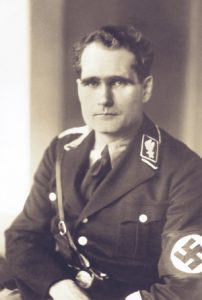
By September 1940, it had become clear that the German Luftwaffe was not going to defeat Britain’s Royal Air Force. Still, Goebbels held out hope that his Nostradamus project would somehow reverse the tide. “Lord Haw-Haw [the pro-Nazi British radio broadcaster William Joyce] is supposed to indicate the prophecies of Nostradamus today, which should now come to be fulfilled,” he boasted. Meanwhile, Goebbels’s new propaganda efforts focused on Hitler’s plan to attack the “Jewish-Bolshevik Soviet Union.” He altered Nostradamus’s original wording about the advent of a “great Prince of Armenia” to have it refer instead to the first-century chieftain Arminius, who had led the Germanic tribes to victory against the legions of Rome. The new reading replaced Russian dictator Joseph Stalin (Armenia) with Adolf Hitler (Arminius). It was just a matter of switching a few letters in one word.
One high-ranking Nazi official, Deputy Führer Rudolf Hess, had his doubts about both the Nostradamus mumbo-jumbo and the overall wisdom of attacking the Soviet Union and precipitating another two-front European war like the one Germany had lost in 1918. After consulting his personal astrologer, Hess secretly flew to Great Britain on May 8, 1941, on an unsanctioned mission to broker peace between the two nations. He crash-landed in Scotland, where he told mystified British interrogators that his mission had been inspired “through a dream by supernatural powers.” When it quickly became clear that Hess was acting on his own, without official government approval—or even knowledge—the British imprisoned the obviously deranged Nazi, beginning a 46-year incarceration that ended with Hess’s suicide by hanging in August 1987.
Hitler, beside himself with rage, demanded an explanation for Hess’s actions. The führer’s personal secretary, Martin Bormann, a longtime bureaucratic rival of Hess, ascribed the reckless act to “political fortune telling.” Goebbels, sensing potential blowback on his own quasi-mystical efforts, agreed, writing in his diary that “the whole obscure swindle is now finally rooted out. The miracle men, Hess’s darlings, are going under lock and key.” Under the direction of Reinhard Heydrich, the fearsome chief of the Nazi security service, the Sicherheitsdienst, or SD, many alleged mystics and occult practitioners were arrested, as was the politically wayward Karl Krafft. Most were quickly released, but Krafft was in and out of prison for the next three years, eventually succumbing to typhus while en route to Buchenwald concentration camp in January 1945. The half-hearted crackdown faltered because the German public remained overwhelmingly superstitious, and the high command itself remained stubbornly attached to various aspects of “scientific” supernaturalism, including research into such potential superweapons as death rays, antigravity machines, super rockets, flying saucers, and even the resuscitation of the dead.
One of the Reich’s first and most ridiculous uses of border science involved radiesthesia, or the harnessing of “earth rays.” By the spring of 1942, Britain’s Royal Navy had enjoyed great success in sinking German U-boats. To locate enemy submarines, the British employed such scientific methods as underwater and surface radar detection systems. They were aided by sophisticated code breaking and the extensive use of heavily armed Allied convoys.
Among the German naval officials puzzled by the sudden shift of fortunes in the Battle of the Atlantic was U-boat captain Hans Roeder. An amateur dowser himself, Roeder was convinced the British were employing similar means to locate U-boats. He suggested that Germany set up its own “pendulum institute” to develop appropriate countermeasures. Receiving approval for the institute from German naval intelligence in September 1942, Roeder proceeded to recruit a small army of pendulum dowsers, as well as astrologers, astronomers, ballisticians, clairvoyants, mathematicians, and psychics. Inside the institute, radiesthesiologists would place a tiny toy battleship on a large map of the Atlantic Ocean spread across a table. They would then swing a one-centimeter metal cube on a short string above the toy ship. If the pendulum reacted, it was supposed to indicate the presence of a real enemy battleship at that location. The laughable experiment failed to produce any meaningful results.
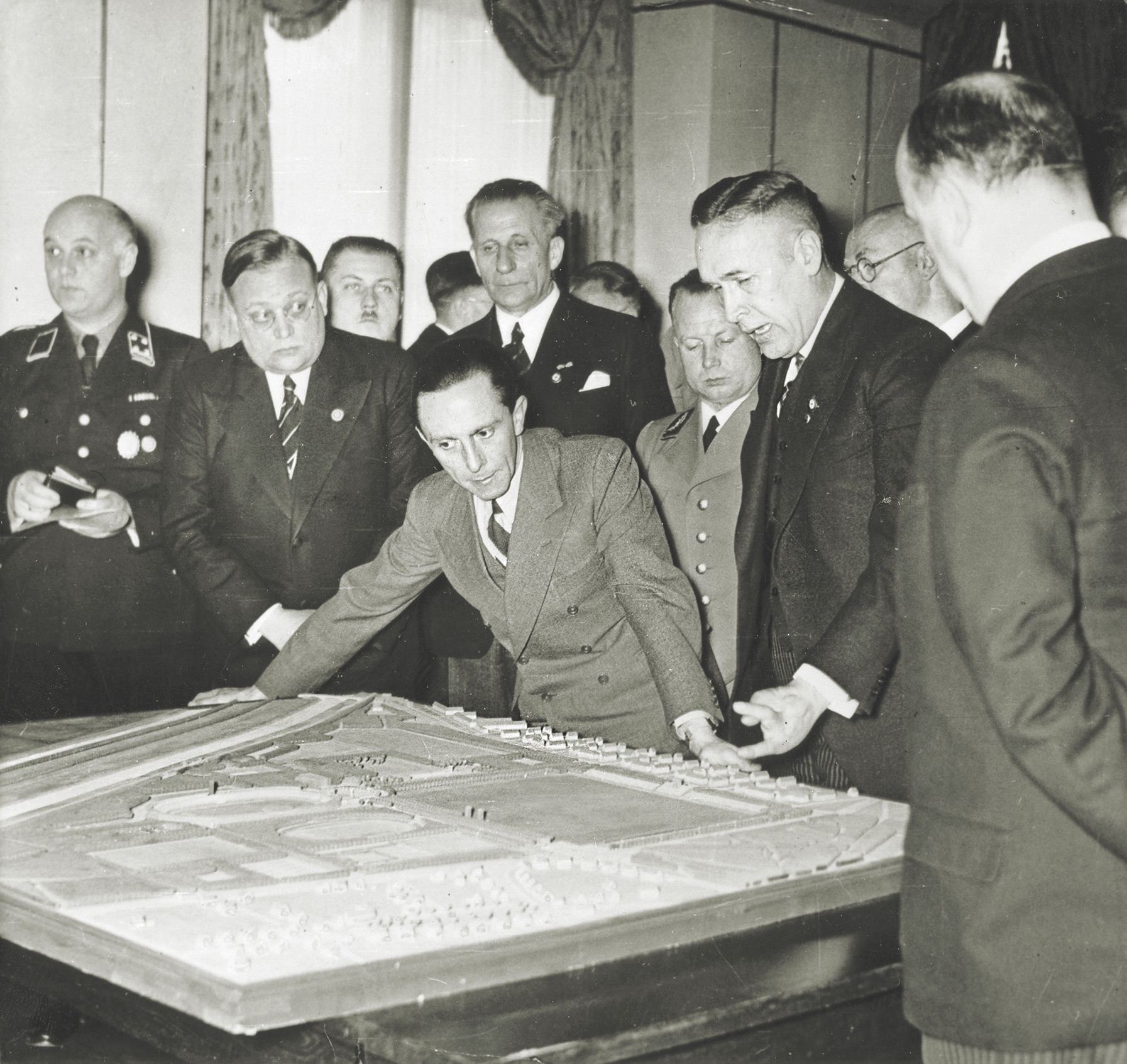
Albert Speer, Hitler’s newly appointed armaments minister, watched the ongoing research into such miracle weapons with great skepticism. He later traced the beginning of the almost religious belief in such weapons to a speech by Baldur von Schirach, the Nazi Party’s national youth leader, on October 6, 1943. “We have a collective secret of which the whole German people are already aware,” Schirach had announced at the time, saying that it was “too early to speak with certainty about the debut of these new weapons.” But sooner or later, he vowed, Germany’s miracle weapons would be put into production and readied for use.
Over the next 18 months Speer tried repeatedly to ratchet down expectations for such weapons—to no avail. Despite his exasperated warnings, the Nazis became increasingly obsessed with developing new, destructive technologies. Certainly, all industrialized nations dreamed of new, improved military technologies. But the leaders of the Third Reich obsessed over the development of miracle weapons. Their “unshakable faith in the power of miraculous discoveries in the context of war,” historian Michael H. Kater has observed, “naturally extended into the sphere of weapons and armaments.” The strictly controlled scientists and laboratories—to say nothing of the endless supply of helpless human subjects from the state’s various prisons and concentration camps—made such fanciful research possible.
Until Speer took charge in February 1942, Germany had no coherent armaments policy. Hitler changed priorities frequently based on a combination of shifting military realities and his own preference for offensive over defensive weapons. One area of agreement among Speer, Hitler, and many other Nazi military leaders, however, was on the need for superior weapons, since the Allies, from 1942 on, would always win the munitions battle in terms of pure numbers. The decision to favor quality over quantity led, in part, to Speer’s emphasis on efficiency and organization as well as to Hitler’s and Himmler’s interest in miracle technologies.
The headlong investment in the development of secret weapons also reflected the Nazis’ continued fascination with border science. As Germany’s military situation deteriorated, the SS insinuated itself directly into armaments production. Working from the SS-sponsored Institute for Practical Military Research, Himmler ordered that dozens of concentration camps, hundreds of SS scientists, and thousands of slave laborers be appropriated for weapons research and development. Himmler agreed with Hitler that qualitative superiority could be achieved by focusing on single weapons.
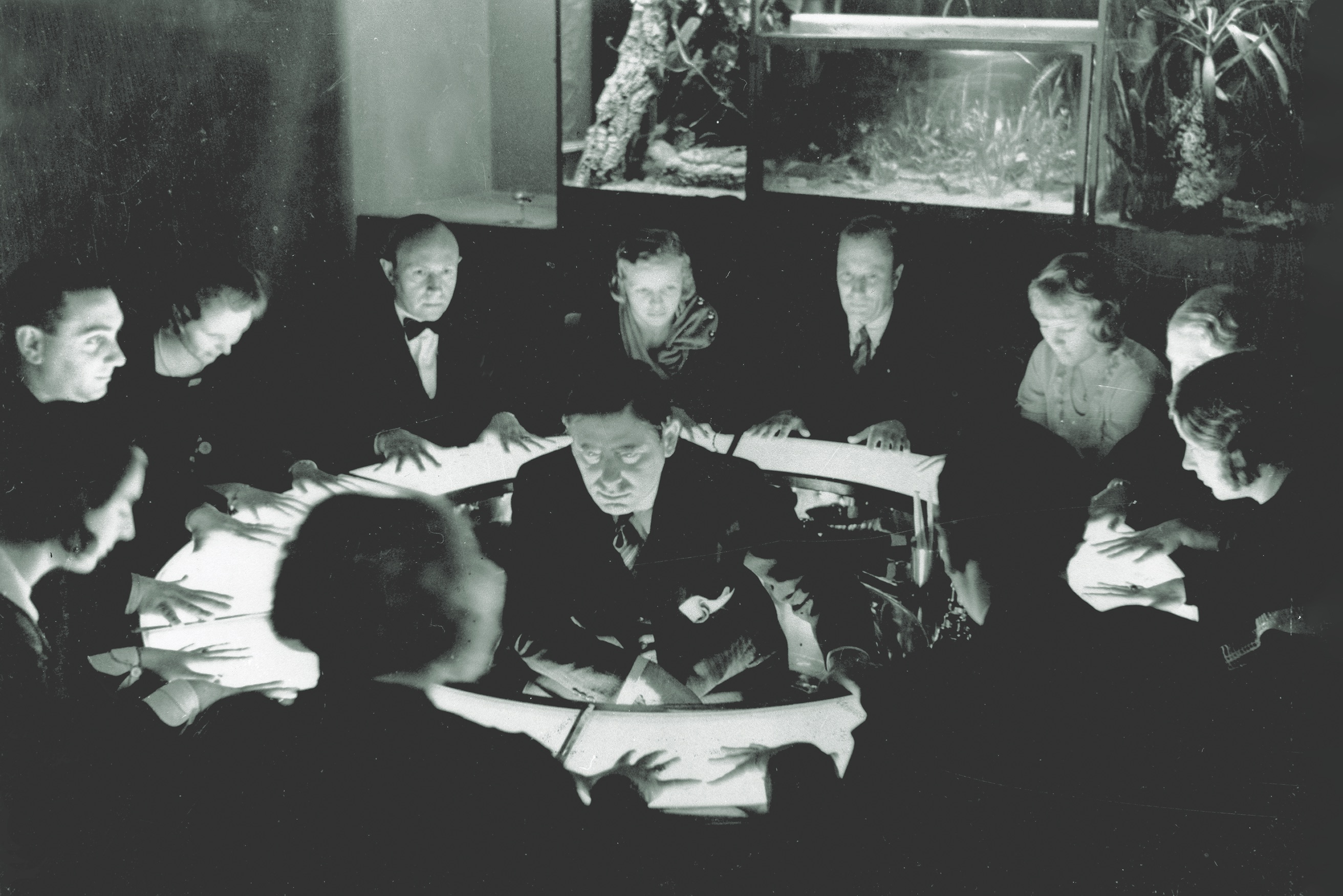
Also like Hitler, Himmler eschewed highly complex projects in favor of technology that was easily accessible or that he was personally familiar with. For this reason, he paid little attention to research into the atomic bomb, preferring instead to invest in fighter planes, rockets, and other weapons reminiscent of early 20th-century science fiction and less dependent, at least theoretically, on the revolutionary new science of atomic physics, which Himmler felt had been dominated by Jewish scientists and theoreticians. By the summer of 1942, German scientists had developed the V-1 cruise missile (V for vergeltungswaffe, or revenge-weapon), and plans for the V-2, the first ballistic missile, were put in place.
In the summer of 1943, Himmler turned briefly from weapons research to border science, assembling a team of astrologers to help locate missing Italian dictator Benito Mussolini, whom the Italian people had deposed and arrested in the wake of the Allied landings in Sicily. For weeks the Italians had been moving Il Duce from one obscure location to another to foil a German rescue operation. On September 12, 1943, Nazi SS officer Otto Skorzeny undertook a daring raid on the Campo Imperatore Hotel in Italy’s Gran Sasso Mountains to liberate Mussolini. (Evidence suggests that the Germans had deduced Mussolini’s location by breaking Allied radio codes, but Himmler insisted that his expert team of radiesthesiologists, astrologers, and other occultists had actually pinpointed the target.) In a matter of hours Skorzeny’s airborne troops, swooping in on DFS 230 gliders, defeated Mussolini’s captors without firing a shot. Whisked off to Vienna, Mussolini was installed as leader of the new Italian Social Republic, a German puppet state.
Increasingly, Himmler focused the SS on aviation research. The SS first concentrated on aircraft production and then, beginning in the summer of 1943, expanded its reach to rockets and other secret weapons. The brilliant young rocket scientist Werner von Braun, who by this time held an SS officer’s rank, continued to work for the German army and air force after 1943. But following a failed attempt to assassinate Hitler in July 1944 that the führer blamed on disgruntled army officers, Himmler assumed complete control of the rocket project, marginalizing the role of von Braun and other experts in favor of ideologues such as SS commander Hans Kammler.
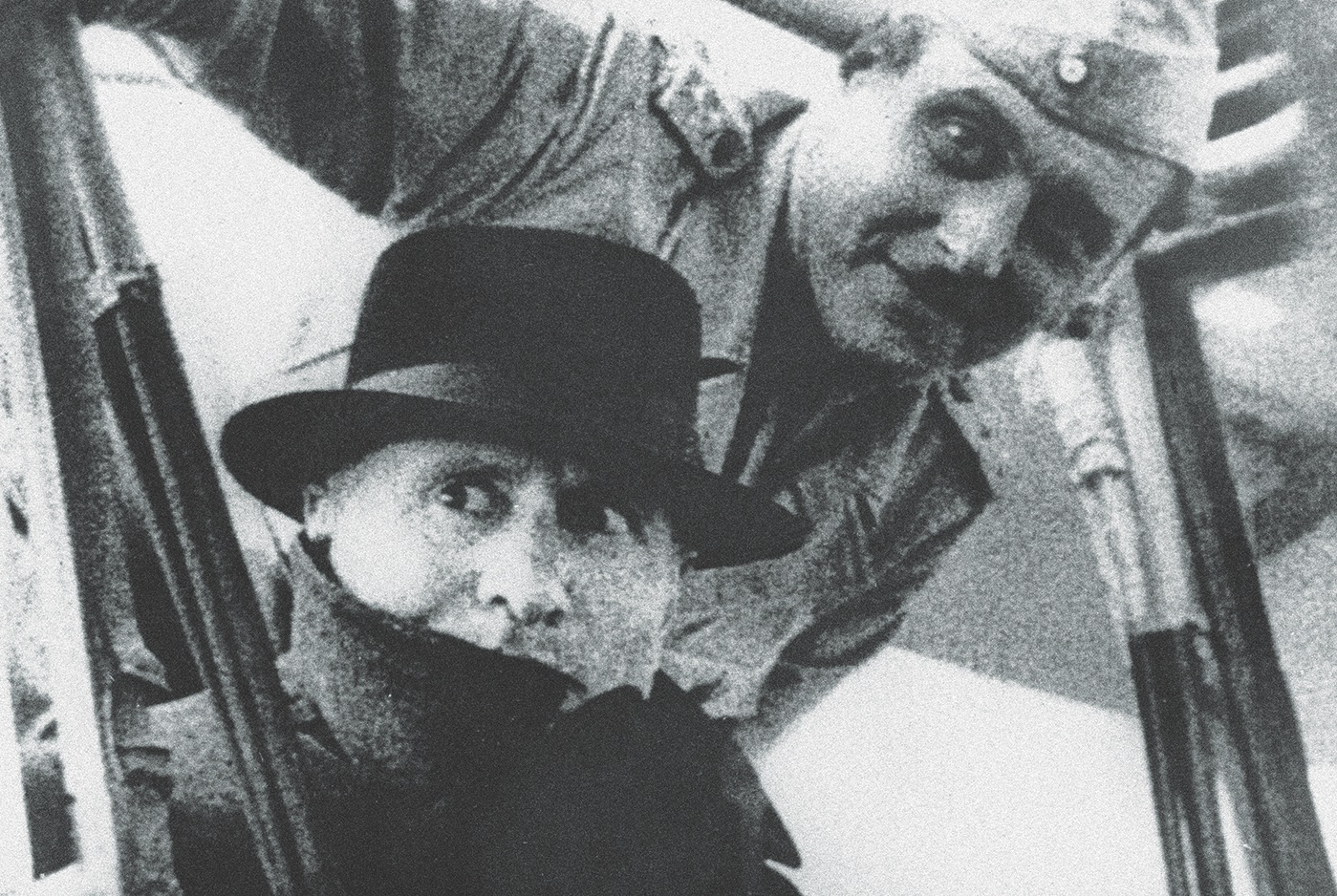
Branded “a diabolical genius” by one historian, Kammler was a civil engineer whose previous claim to fame was expanding the cremation facilities at the Auschwitz concentration camp and extermination center in southern Poland. There Kammler had gained a reputation for ruthless efficiency, and Himmler tapped him to head the Third Reich’s rocket program. Beginning in July 1944, Kammler collaborated with Speer in building underground research facilities near the Harz mountains in Thuringia, enlisting thousands of concentration camp prisoners as slave laborers.
As Kammler and the SS continued to make unrealistic promises for the rocket program over the summer and
fall of 1944, Speer became increasingly cautious. In early August 1944, even as the long-awaited V-2 rocket was readied for its first launch, Speer warned, “We cannot depend on the effect of these new weapons as a completely certain matter.” Four weeks later he admonished Goebbels to play down the Propaganda Ministry’s bombastic campaign on behalf of the V-1 and especially the new V-2. While acknowledging many important developments in the rocket program, Speer tempered the good news with a harsh dose of realism. “It is necessary in this circle to make clear that these new weapons cannot promise a universal panacea,” he said. Goebbels shouldn’t promise miraculous results from the V-2, Speer argued, because while the rocket might surprise the Allies, it likely would not have a decisive impact on the war’s outcome. “Our new weapon,” he concluded, “will require considerable time before it has any effect.” Speer’s admonitions were borne out by intercepted reports from the British and Americans observing that the military value of the V-2—and the likelihood of the V-3 ever reaching New York City—was so negligible that the Germans must have developed them only for their diversionary value.
Aside from Speer, however, nearly every high-ranking Nazi seemed to believe that miracle weapons such as the V-2 and V-3 could actually turn the tide of war in Germany’s favor. On September 15, 1944, shortly after the V-2 was first deployed, Speer delivered a sobering message to a group of Germany’s top political and military officials. “It is questionable whether it is the right thing to do, in such a difficult moment, to create disappointment which cannot but have an unfavorable effect on our military morale by encouraging hopes that cannot be fulfilled in so short a time,” he told them. “[Insofar] as the population waits daily for the miracle of new weapons, continuing to withhold these new, stockpiled weapons can no longer be explained, it raises the question as to whether this propaganda makes sense.”
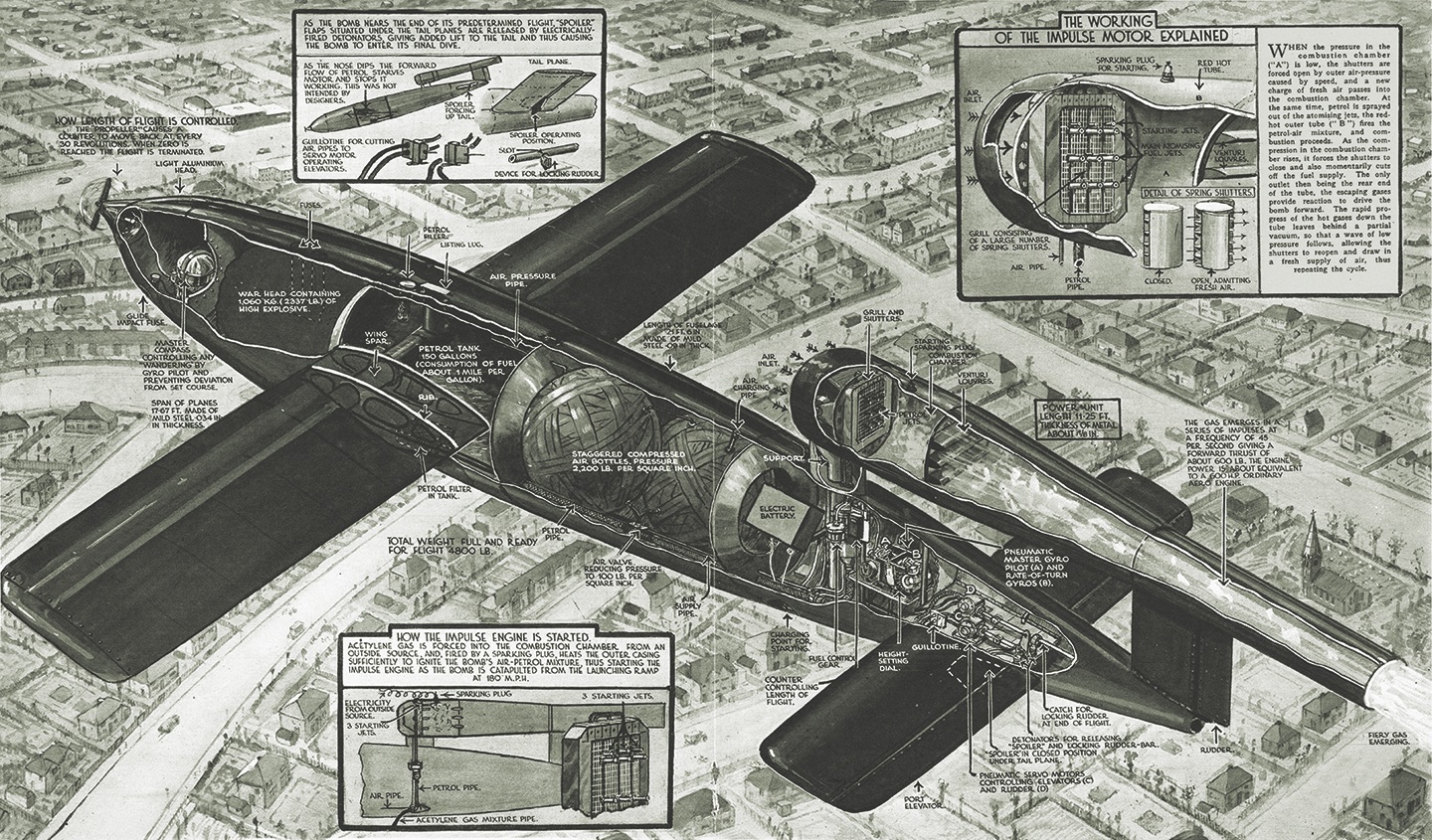
In December 1944, Speer followed up with another detailed briefing. “You have gotten today a small insight into the various new developments which have been completed recently,” he said. “You have certainly seen that we do not have and never will have a miracle weapon. It has always been clear, for anyone who wants to know it, that miracles in the technical sphere, as expected by lay people, are simply not possible.” Frustrated by Speer’s pushback, Himmler instructed Kammler to set up his own secret projects office within the Ahnenerbe, a Nazi think tank that Himmler had established as an appendage of the SS. Set up in the Škoda Works , a weapons and manufacturing complex in Bohemia and Moravia, the office was to work on such exotic weapons as antigravity devices, guided weapons, and antiaircraft lasers, dubbed “death rays.”
Himmler turned to a young Luftwaffe colonel named Schröder-Stranz, who had previously attempted, without success, to get the Luftwaffe to sponsor his “ray device” (strahlengeräte). When Speer attempted to convince Hitler not to invest in any new weapons projects, Himmler and Schröder-Stranz countered by arguing that the ray device “apparatus” was not a weapon because it could also produce “healthy” rays. When the device proved ineffective as a weapon, Schröder-Stranz claimed that it could be repurposed as a “detection device” (mutungsgerät) to find hidden oil reserves, a prospect that, owing to the Reich’s critical lack of natural resources, excited Himmler.
As Schröder-Stranz worked on his death ray device at the Dachau concentration camp outside Munich, Himmler enlisted border scientists in an effort to locate gold reserves for the Reich. He focused the search on the Rhine and Inn rivers. Inspired by Richard Wagner’s bombastic opera Das Rheingold and the local lore of his youth in Braunau-am-Inn, Himmler insisted that the two rivers, as well as the Isar River in his hometown of Munich, had considerable untapped resources. Since mainstream geologists had found no substantive evidence of gold in these river valleys, Himmler enlisted the help of SS geophysicist Karl Wienert. Undaunted by the fact that little gold had been found anywhere in the Reich—perhaps one viable mine in Silesia and five in eastern Germany—Wienert and Himmler pushed forward with their project, citing circumstantial evidence that people had successfully panned for gold in the Rhine and Isar in the 18th century.
After Wienert’s efforts proved unsuccessful, Himmler decided to bring in Josef Wimmer, another famous border scientist. Wimmer had built his reputation water dowsing for the Bavarian government in the 1930s. During the war Himmler gave Wimmer various esoteric tasks, such as using his divining rod to look for bombs planted in the synagogues of Kraków, Poland. He also enlisted Wimmer to train teams of water seekers in the homeopathic gardens at Dachau, which had become a center of wide-ranging border science activity. Eventually, disgusted by the lack of progress, Himmler pulled the plug on the fruitless search for river gold.
As Germany’s military situation grew more desperate, Himmler pursued new weapons inspired by Germanic mythology. In October 1944, Elemag, a company in Hildesheim, proposed a weapon loosely based on Austro-Croatian inventor Nicola Tesla’s groundbreaking experiments in electricity. The new miracle weapon would use the insulating material in the atmosphere as a means to weaponize electricity. Himmler’s enthusiasm for Elemag’s proposal was based not on his familiarity with Tesla but on his belief in the untapped electrical power of the universe that he thought could be harnessed with appropriate technologies. He instructed the Reich Research Council to review Elemag’s proposal, but the council disappointed him by concluding that the weapon was impossible to develop with existing technologies.
While Himmler was busy pursuing his pet projects, Kammler was sponsoring large-scale efforts across the Reich to weaponize border science. The most ambitious of these efforts was an antigravity device known as “the Bell” (die Glocke), one of many top-secret weapons experiments surreptitiously carried out in Nazi-occupied eastern Europe. According to Polish intelligence, a number of German scientists and test subjects died in late 1944 and early 1945 while they were working on some kind of nuclear-powered, antigravitational device, or “flying saucer,” at a facility in Lower Silesia near the Wenceslaus mine on the Czech border. The efforts, predictably, came to naught.
The most ghoulish of the Nazis’ quasi-scientific experiments centered on Himmler’s deluded efforts to resuscitate dead German pilots who had crashed into the icy Atlantic Ocean and succumbed to extreme cold. Acquiring prisoners from various concentration camps, experimenters dropped them into tanks filled with freezing water, waited until they lost consciousness, and then attempted to revive them by using artificial (and sometimes human) heat. The experiments failed, and more than one-fourth of the 300 “volunteers” perished. Other heartless experiments involved injecting inmates with cancer, typhus, and malaria in a vain attempt to develop a cure for the dread diseases. Anyone who objected to the inhumane experiments, said Himmler, was nothing less than a traitor who “preferred to let brave German soldiers die.”
The failure of such experiments was not, strictly speaking, the fault of science. As German physiologist Viktor von Weizsacker noted after the war, the human experiments may have been conducted under the mask of science, but in reality they were “nonsensical and harmful.” In one way or another, the same could be said for the Nazis’ long infatuation with all occult practices, miracle weapons, and astrological propaganda. One can only speculate
how much more effective the German war effort might have been without the proclivity, from Hitler on down, to indulge in miraculous thinking. Parapsychologist Hans Bender, sitting in an American internment camp in 1945, was unapologetic. The West’s preference for rational thinking, he maintained, was misguided. “Thinking is an indication of the decay of the brain,” Bender said. “Every time a person thinks it is a sign that a brain cell has died and deteriorated, and the result is a decomposition of thought.” While humans poisoned themselves with too much thought, “a panther is too clever to think. We must destroy thinking, killing it in its very beginning so thoroughly that it destroys the multiplication of micro-organisms as in an infected wound.”
It is unlikely that Germany could have won the war even had Nazi leaders shed their obsession with the supernatural and committed themselves to a more rational, pragmatic approach to decision-making. But the human, material, and psychological investments wasted on so-called miracle weapons and border science seriously hindered the German war effort. For that reason alone, the civilized world can only give continued thanks to Hans Bender and his crackpot ilk. MHQ
Eric Kurlander is a professor of history at Stetson University in DeLand, Florida. He is the author of three books, including, most recently, Hitler’s Monsters: A Supernatural History of the Third Reich (Yale University Press, 2017), from which this article is adapted.
[hr]
This article appears in the Summer 2020 issue (Vol. 32, No. 4) of MHQ—The Quarterly Journal of Military History with the headline: Obsessed with the Occult

Want to have the lavishly illustrated, premium-quality print edition of MHQ delivered directly to you four times a year? Subscribe now at special savings!

